Excerpts from Jim Conrad's
Naturalist Newsletter

from the June 16, 2013 Newsletter issued from the valley of the Dry Frio River in northern Uvalde County, southwestern Texas, on the southern border of the Edwards Plateau; elevation ~1750m (~5750 ft); N29.62°, W99.86°; USA
GOLDEN ZUCCHINI
When Malle the Estonian lady friend returned to Estonia a few weeks ago, as a going-away present she presented me with a potted squash plant bought at the Uvalde Wal-Mart. The plant didn't have a name on it, just a tag saying that all summer it'd produce large, yellow squash.
Transferred to the garden, the plant grew fast, soon becoming the most eye-catching and robust citizen of the garden. Above you can see the knee-high plant spreading its kite-size leaves over cardboard spread across the garden to conserve moisture, in lieu of having enough compost.
A close-up of flowers and a ten-inch-long (25cm) fruit is shown below:
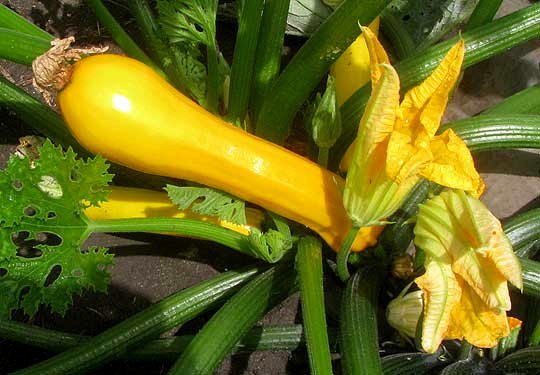
The plant with its enormous, deeply divided, silvery-mottled leaves is very unlike other squash plants in the garden, and the squash fruits look a bit strange being so cylindrical and with faint ribs, so what is this?
We can all see that it's a member of the Squash/Gourd/Melon Family, the Cucurbitaceae. But that's a big, important family, embracing some 125 genera and 960 species. Of all plant families, a webpage sponsored by Purdue University says that the Cucurbitaceae produces the most species used as human food.
If you "key out" which Cucurbit genus our plant belongs to, when you notice that the fruit is fleshy and not splitting open when mature, that the fruit contains many seeds, that the corolla's lobes join together to form a bell-shaped corolla, and that the stamens' baglike, pollen-producing anthers attach to one another forming a single anther mass, you find that you have the genus Cucurbita, in which occur pumpkins, squashes, certain gourds, and the like. Cucurbitaceous species not in the genus Cucurbita include the cucumber (genus Cucumis), luffa gourds, and a large number of wild vines producing fruits you'd never think of eating.
By the way, you may be interested in seeing what the grown-together anthers of a squash flower's stamens look like. You can see it, with a Cucumber Beetle mugging for us, below:

So, we have something in the pumpkin/squash arena, but what is the species? Making the same kind of analysis and noting that the squash fruit produces white seeds, and that the leaves are deeply lobed and rather rough or scratchy feeling, we come to Cucurbita pepo, one of the most horticulturally important of all plants, a species from which many dissimilar fruits have been coaxed. Field pumpkins, yellow crookneck squash, acorn squash, egg squash, Zucchini, spaghetti, 'Delicata' squash and many other squashes all derive from this single polymorphic species. Cucurbita pepo is thought to have been domesticated first in Mexico. But, even in Mexico I've never seen anything like the one in our pictures.
Cucurbita pepo is regarded as being divisible into several varieties, including:
Of these varieties, the one producing large, fast-growing, cylindrical fruits with low, angular ridges or ribs is the variety cylindrica. Therefore, what we have is something very like a zucchini, maybe even just a yellow form of zucchini, which normally is dark green.
Figuring that out, on the Internet you can find squash fruits looking like ours labeled "Yellow Zucchinis" and "Golden Squash." They're hybrids, and different companies sell them under different names.
Whatever the name, this robust and beautiful plant is a wonderful gift, one that evokes pleasant memories and the prospect of some good eating this summer.
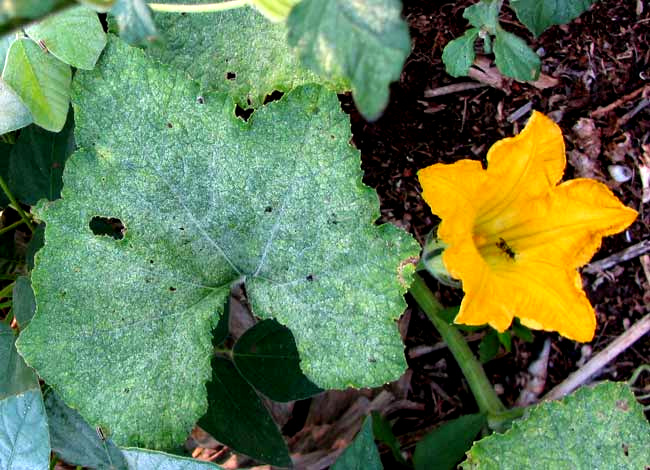
from the the November 28, 2010 Newsletter issued from Hacienda Chichen Resort beside Chichén Itzá ruins, central Yucatán, MÉXICO
SQUASH FLOWERS & FRUITS
Plenty of celebrating goes on at this time of year down here, but last Thursday was regarded as just another day. However, I remembered past Thanksgivings up North, so Thursday afternoon in the organic garden I found a squash, boiled it in a pot over my hut campfire, and that was my Thanksgiving supper.
Actually, I'm not sure what you'd call the item I ate. It's a traditional Maya crop, not really like what most English speakers think of as a squash, pumpkin or gourd. It was a cultivar of CUCURBITA PEPO, a native American species from which a rainbow of field pumpkins, yellow-flowered gourds and summer and bush squashes have been horticulturally derived. That's a leaf and flower of the thing I ate above.
Flowers in the Squash Family, the Cucurbitaceae, are unisexual. Since the flower in the above picture has a small fruit at its base, it's a female flower. A closer look inside that female flower is shown below:
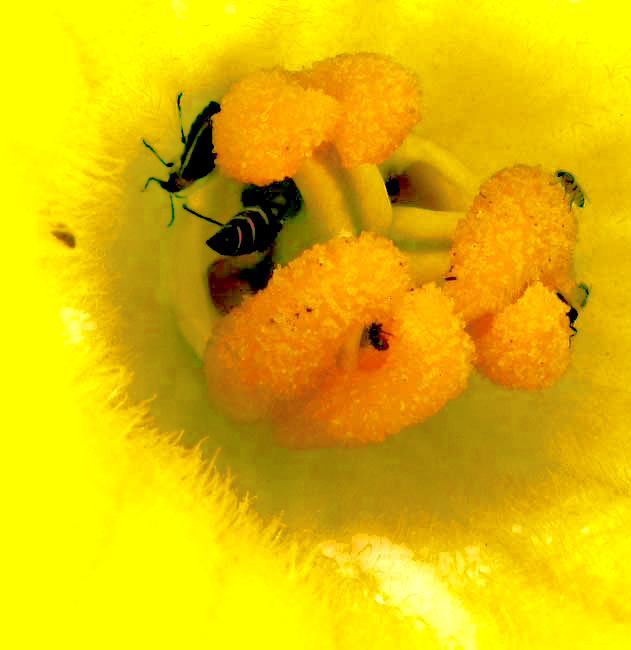
The hairiness of the yellow corolla walls provides a foothold for pollinators entering the flower. The immature fruit beneath the corolla is a developing "inferior ovary," which means that the corolla arises above the ovary, not at its base, as with "superior ovaries." The ovary's slender neck, or style, has three branches, and at the tip of each style branch there's a two-lobed stigma. The stigma is where pollen from male flowers germinates. In the above picture, notice what appears to be a cup at the corolla's bottom. A pollinator busy inside the cup is gathering nectar. One side of the corolla has been removed so you can see both the cup and the developing fruit below:
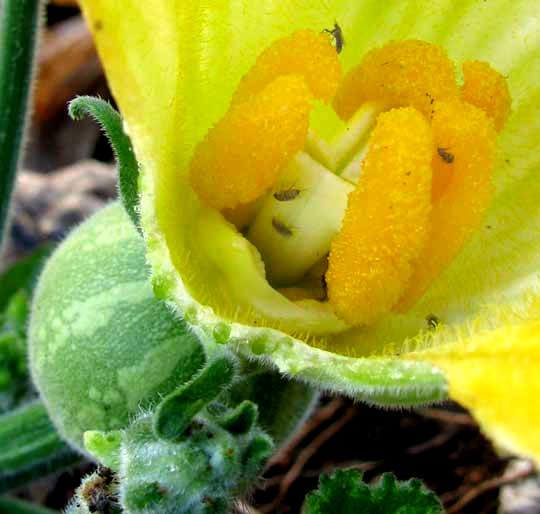
The cantaloupe-size meal on my table is shown below:

You may recognize this squash as an "heirloom" variety sometimes known as the Globe Squash, Round Zucchini or Ronde de Nice. I'm not sure if it's the same thing. It may be the Maya ancestor of those cultivars.
I do know that the white seeds were as tasty as the flesh and that the flesh, when teased, became stringy. I've heard of "spaghetti squash," so maybe that's close to this. It tasted good, though not as sweet as field pumpkin or as flavorful as summer squash -- more like zucchini. The rind was like thin, brittle plastic, not as soft as regular Zucchini's.
from the December 12, 2010 Newsletter issued from Hacienda Chichen Resort beside Chichén Itzá ruins, central Yucatán, MÉXICO
RANDOM SQUASHES
This week Wilfrido cleaned up what remained of the traditional cornfield, or milpa. Most of the cornstalks already had been ridden down by coatis and stripped, the squash vines had died back leaving mature squash nestled among the weeds like Easter eggs, and the beans really hadn't amounted to anything this year. Mainly the job just entailed piling all the herbage into a heap for burning, and gathering all the squash in one place. You can see one corner of a large spread-out collection of squash/pumpkin fruits below:
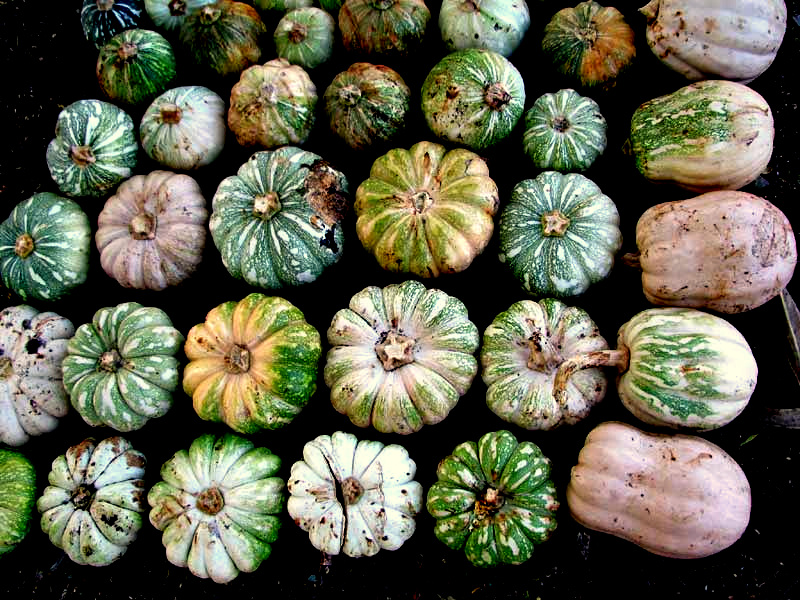
Just how many different kinds of traditional Maya squash/pumpkin fruits are shown in that picture? We've already looked at the smallish Globe Squash, or Round Zucchini, represented in the picture's upper, left corner. It tastes like zucchini, but the others have a firmer texture and are sweeter, more like the Northern pumpkin.
Some people call the flattish, broadly ribbed fruits in the picture's center Striped Pumpkins. The one in the picture's lower, right corner is, or is close to, a Delicata. Most of the rest seem to be intermediate forms of these "pure types." As was the case with our previous Globe Squash, all these are just cultivars of the species CUCURBITA PEPO. They're like the many dog races, which eagerly intermingle if given a chance, since they're all the same species. Wilfrido thinks that all the Maya traditional squash types are shown, except for a small, black one, for which no seeds could be obtained.
Whatever they're called, it's always a pretty moment when the season's squash and pumpkins are all brought in and lined up for display, just in time for all the many fiestas celebrated at this time of year.